
Altar Screen
Scroll to the bottom for the latest reflection
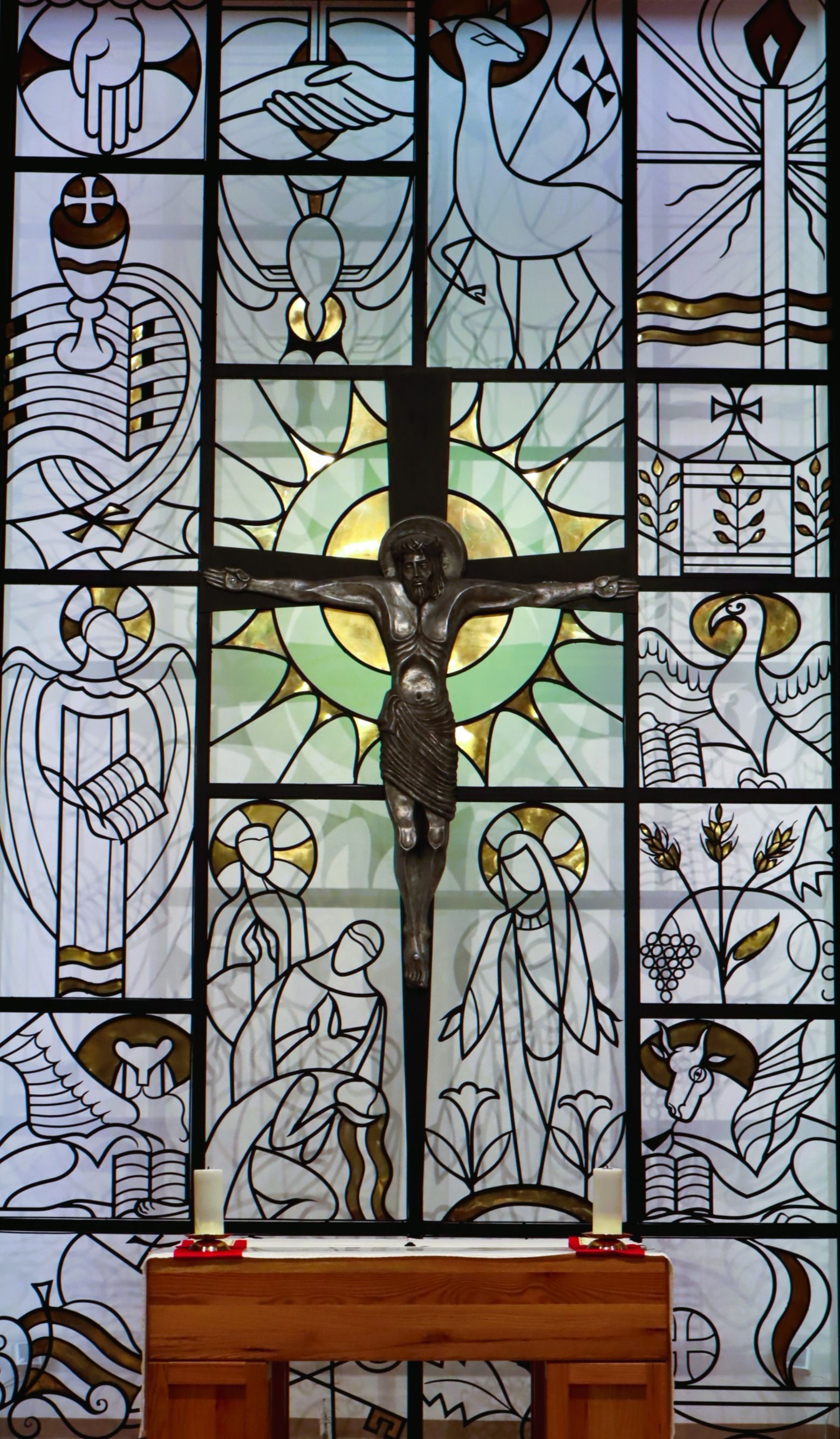
Introduction
The Altar Screen behind the altar at St. John XXIII was installed during the renovation of the worship space that occurred in the summer of 2022. Though it was new to us at that time, it was inherited from the chapel at Immaculate Heart of Mary Seminary in Santa Fe, New Mexico. The Archdiocese of Santa Fe sold the seminary, which had been used as a conference and retreat center in recent years, and St John XXIII parish was fortunate enough to receive the Altar Screen, which had been in the sanctuary of the chapel since the early 1960s, when it was decommissioned.
The artist behind the Altar Screen is a sculptor from Chicago who moved to Santa Fe in 1955, Donna Quasthoff. Gilbert and Son of Albuquerque executed the ironwork from Quasthoff’s panel designs. The original Corpus was Nambeware struck by workmen in Nambe from a cast sculpted by Quasthoff, and the current Corpus is made from her mold of the original in a material that uses both metal and plastic.
Over the next several weeks, we will explore the individual panels of this Altar Screen and reflect on the symbols and meaning each one holds.
The Incarnation
One of the central images of the Altar Screen is the central tenet of our faith: the incarnation. Jesus Christ, the Son of God, was born into the world through Mary to save humanity from sin. This depiction of Mary at the Annunciation is the turning point of our salvation. The lilies represent her purity and innocence as well as humanity’s new beginning. Mary’s arms are open in acceptance of her role as “Theotokos,” or “God-bearer.” Through her cooperation, the Word was made flesh. This image stands at the foot of the cross just as this event stood at the foot of Jesus’ life, ministry, death, and resurrection.
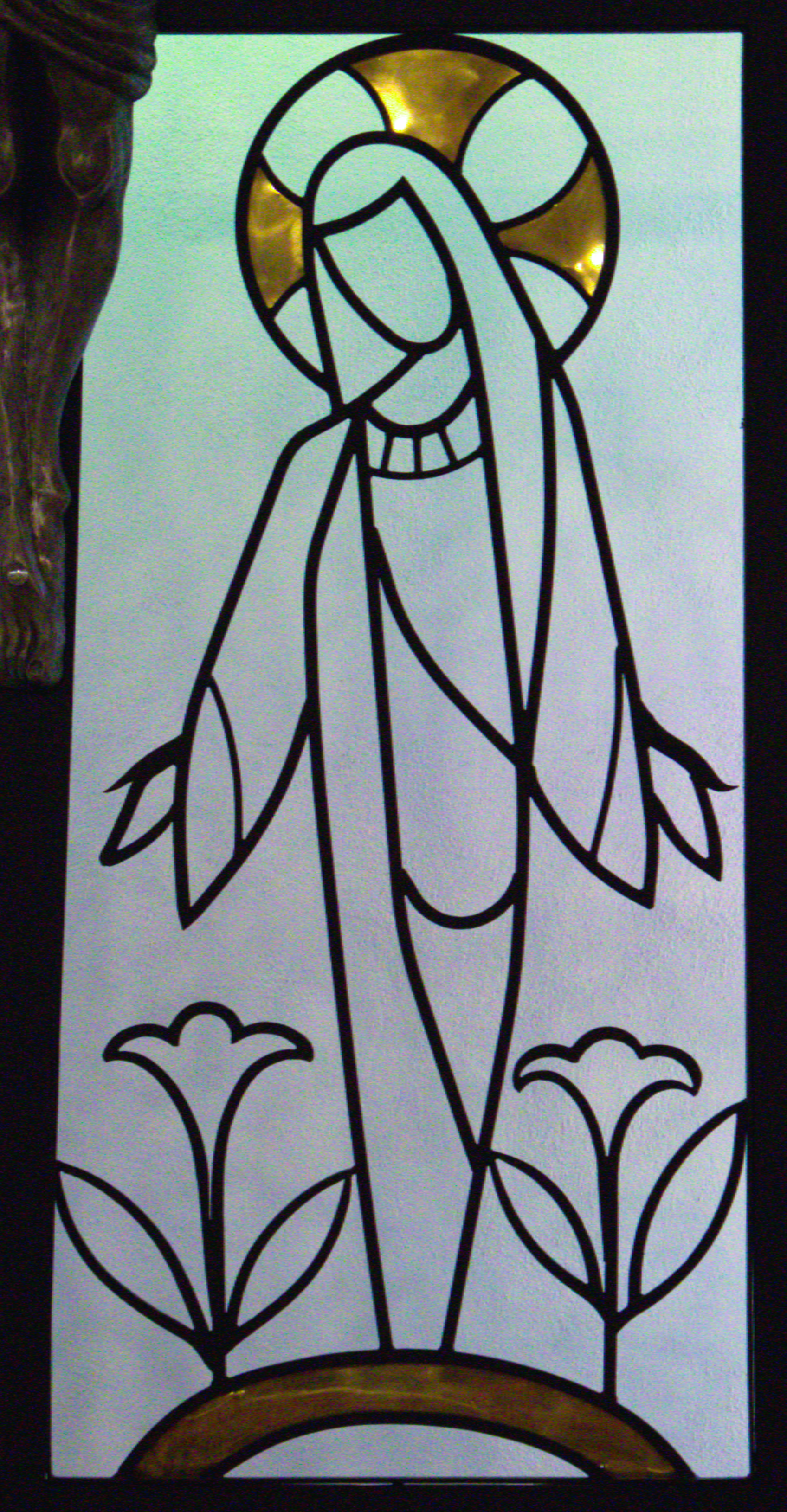
Witness to the Crucifixion
The other central image of the Altar Screen is a depiction of three witnesses to Christ’s crucifixion: Mary, the mother of Jesus, John, the beloved disciple, and Mary of Magdala, who will be the first to proclaim the news of his resurrection. These three witnesses lend us inspiration and provide a model for our own witness to the Paschal Mystery.
Mary is standing. It is undeniable that her suffering would have been second only to Jesus himself, and yet her love, faith, hope, and strength steady her enough to remain standing through her ordeal. The weight of our own suffering can feel oppressive, but there is strength to be found in our witness to the Body and Blood of Christ.
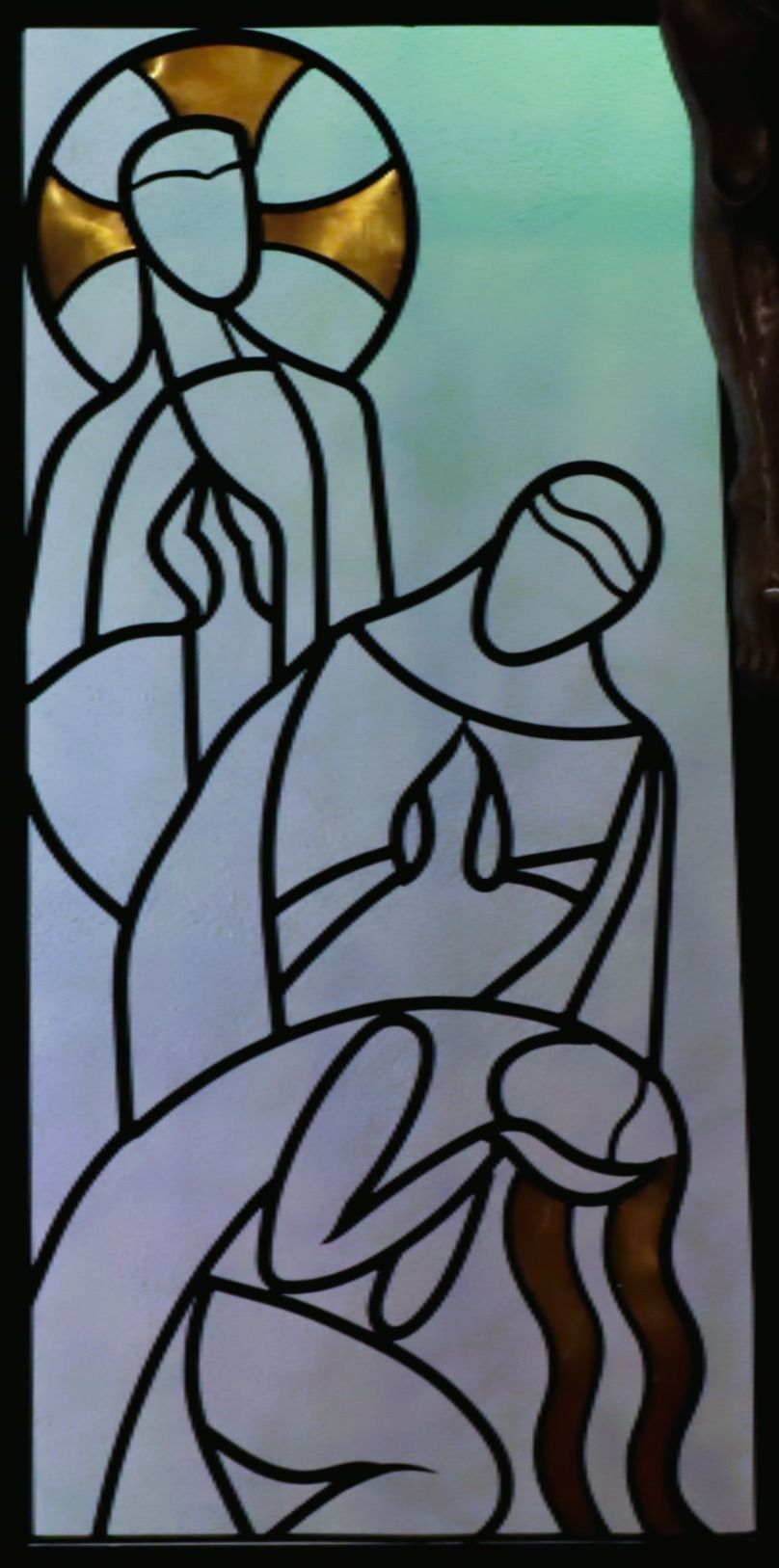
John is bowed down. Despite his own suffering, he accepts Jesus’ instruction to care for Mary as his own mother and receives the care of Mary in return. The way his head is inclined also speaks about extending that care to others as he is doing for Mary of Magdala beside him. We, too, received Mary as our Spiritual Mother and have been instructed to reach out with the care and compassion we have received, despite being bowed down by our own circumstances of suffering.
Mary of Magdala is collapsed and weeping. Though the Gospel depicts her this way at finding the empty tomb and not during the crucifixion itself, it is easy to accept that the weight of suffering can cause us to respond as Mary does. And yet, despite her overwhelming grief, she was present while many of Jesus’ other disciples were not. Her example of witness can inspire us to keep bringing our broken, suffering selves to being present to and with Jesus.
The Evangelists
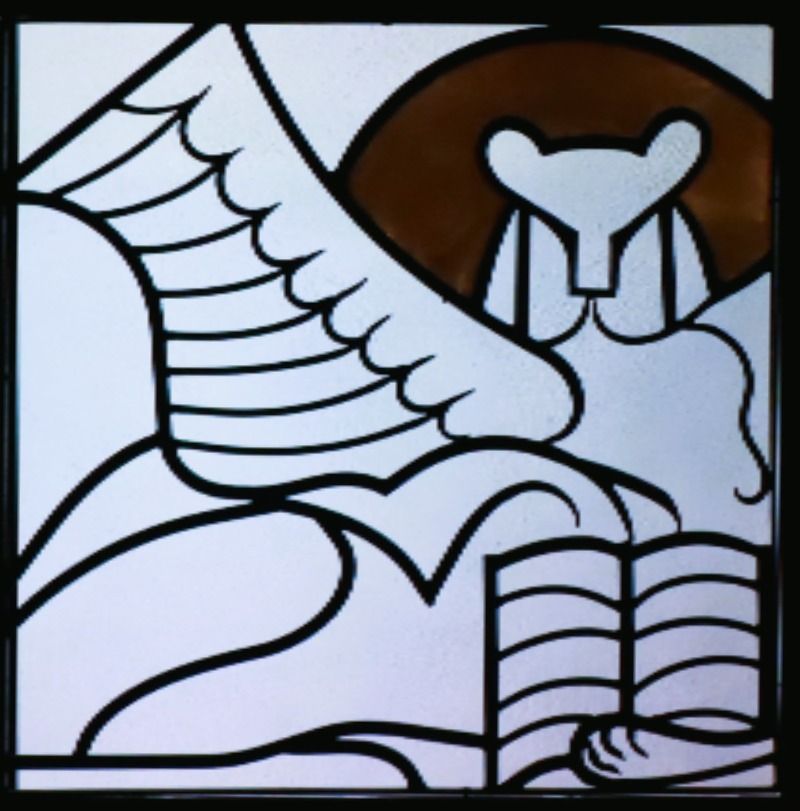
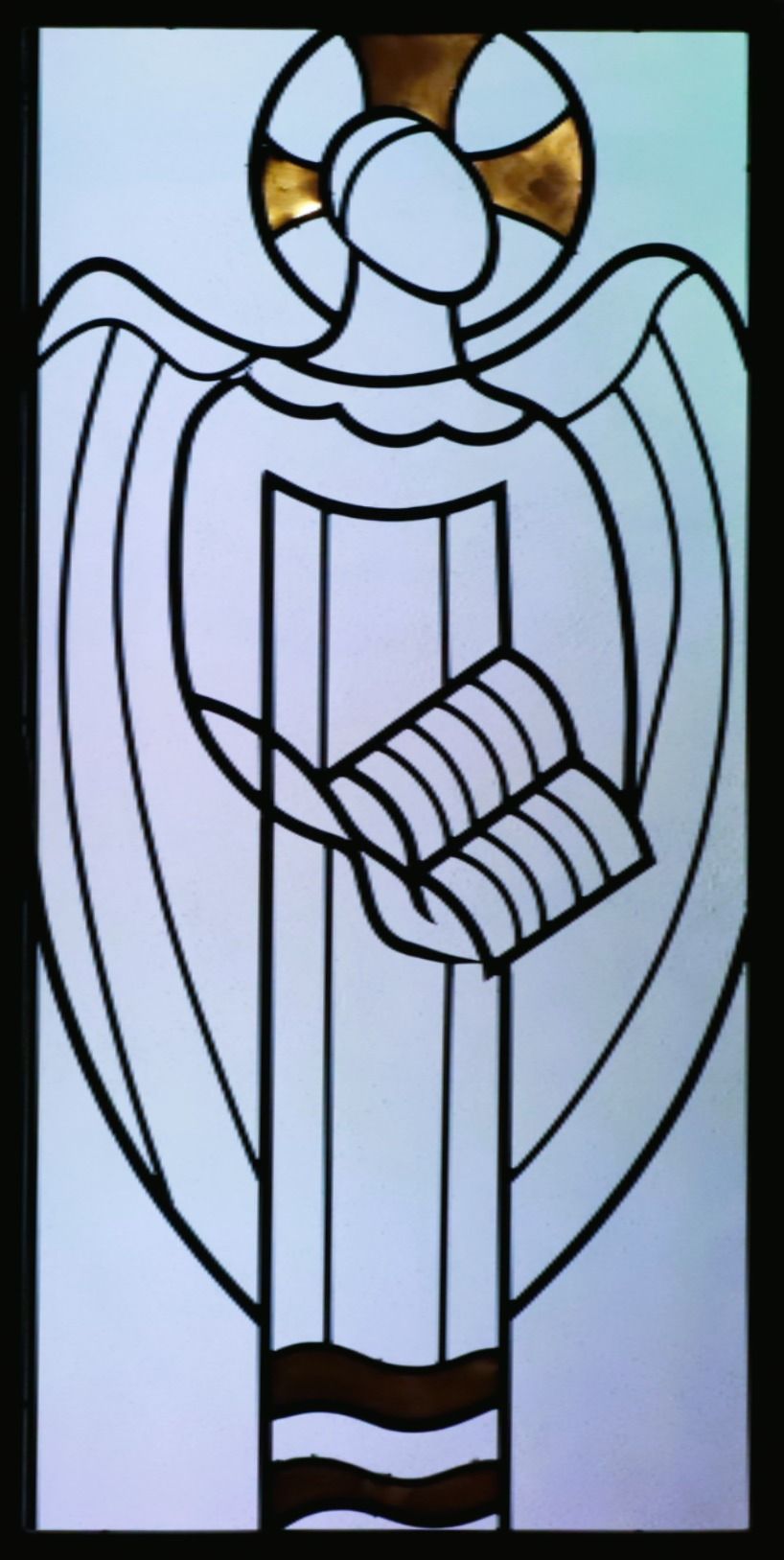
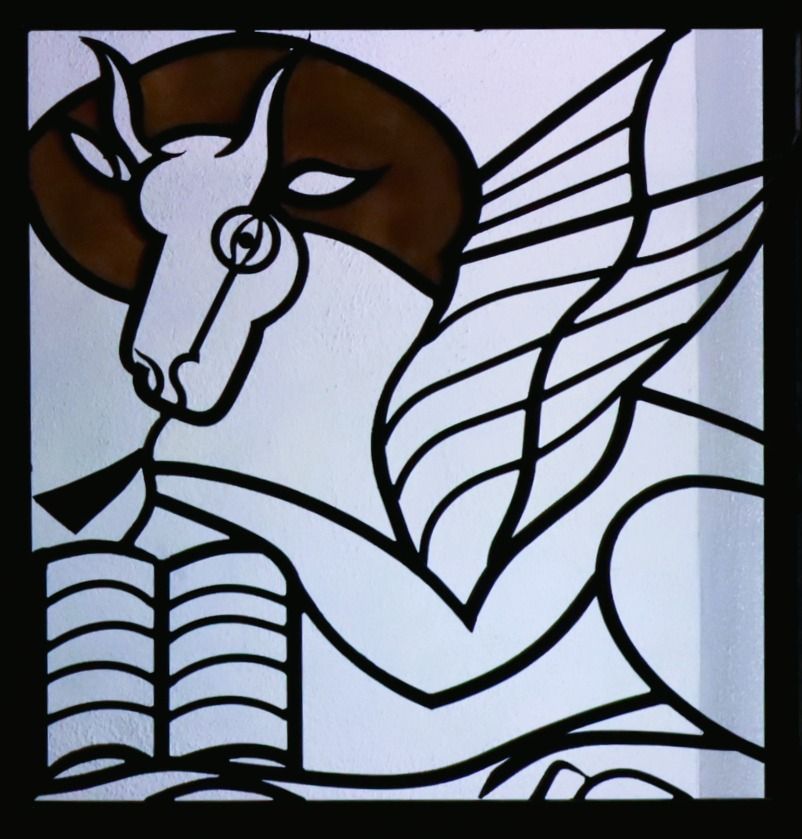
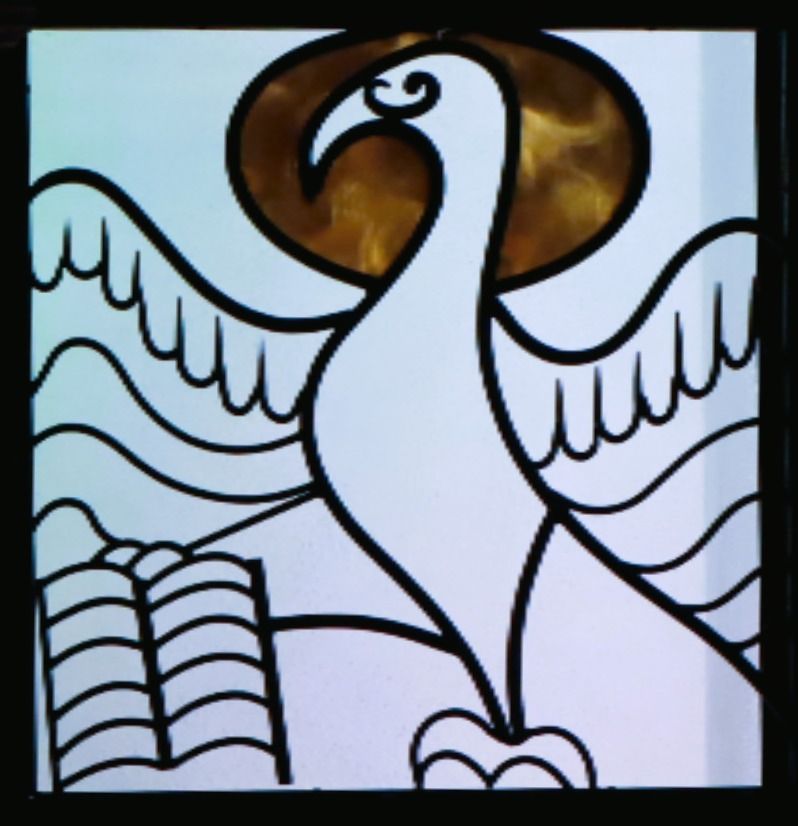
Matthew, Mark, Luke, and John are the attributed authors of the first four books of the New Testament. Called Gospels, which means “Good News,” these four books tell of Jesus’ life, ministry, teaching, Passion, death, and Resurrection. A prophetic vision by Ezekiel and referential scene in the Book of Revelation are interpreted as including a depiction of the Four Evangelists (from Euangelion, which is the Greek word for Gospel) as winged creatures with books, symbolizing their role as messengers of God’s Word.
The winged lion is St Mark. Though placed second in the canon of the New Testament, it is widely accepted that Mark’s Gospel was written first among the four. It is the shortest NT Gospel and it begins with John’s preaching in the wilderness and Jesus’ baptism in the Jordan. This is one reason Mark is depicted as a Lion since John’s voice is described as a roar. Another reason for the depiction as a Lion is the energy of this Gospel. It races from event to event- identifying Jesus as the Son of God from the outset and taking the reader on a fast-paced journey to the Crucifixion and Resurrection. One more connection of Mark and his Gospel with a lion is a prophetic poem from the Book of Genesis that foretells a Messiah very much like the way Mark portrays Him: the Lion of Judah, showing courage and strength in facing opposition and death.
The winged man is St Matthew. One of the faces of the creature in Ezekiel’s vision and the Book of Revelation is human, and this representation has been ascribed to Matthew due to his emphasis on Christ’s humanity. His Gospel begins with a genealogy of Jesus beginning with Abraham. The Gospel of Matthew is one of the synoptic Gospels, along with the Gospels of Luke and Mark. Mark’s Gospel seems to have been a source for both of the other two synoptic Gospels since you will find 88-90% of the content of Mark within them. Matthew’s expansion of Mark’s Gospel emphasizes the Incarnation- when God became man in the person of Jesus- by including an infancy narrative. This attention to Jesus’ lineage and birth along with Matthew’s portrayal of Jesus as a meek and humble “Son of David” draw the reader into identifying with the teachings of Jesus as possible, liveable avenues for discipleship. Jesus’ peace, mercy, and love are attainable as humans and not just a byproduct of His divine nature.
The winged ox is St Luke. The Gospel of St Luke, which is written by the same author as the book known as the Acts of the Apostles, is the last of the synoptic Gospels. The creature that represents this Gospel is the winged ox due to the use of oxen as temple sacrifices. This Gospel begins with a story about Zechariah, who had priestly duties at the temple and was the father of John the Baptist. From this beginning, Luke’s Gospel highlights the sacrificial nature of Jesus’ life and ministry and prepares us to understand the significance of his ultimate sacrifice for our sins and our salvation. Oxen are used for their strength and have a role in our service, which is how Luke portrays Jesus: as a servant leader who calls us to play a supportive role in the lives of others. Throughout the gospel, Luke calls upon the Christian disciple to identify with the master Jesus, who is caring and tender toward the poor and lowly, the outcast, the sinner, and the afflicted, toward all those who recognize their dependence on God.
The eagle is St John. The Gospel of St John is quite different in character from the Synoptic Gospels. While the other 3 Gospels are largely focused on the narrative of Jesus in a biographical way, John utilizes his narrative in a theological way. The eagle, then, is attributed to John since it focuses on that which “comes from above” and it attempts to reveal more than what can be readily seen. Also, as the traditional author of the book of Revelation, too, John’s perspective soars “beyond the horizon.” This does not mean that the events in the Gospel of John are less accurate than the Synoptic Gospel, it is just that John develops the significance of those events and is less concerned with their chronological order. When reading and reflecting on the Gospel of John, it is important to remember that his goal was to invite us to encounter Jesus, see his divine nature, and embrace the life He offers through faith. He wanted to report the signs of Jesus so that we “may come to believe that Jesus is the Messiah, the Son of God, and that through this belief we may have life in his name.”
One, holy, catholic, and apostolic Church
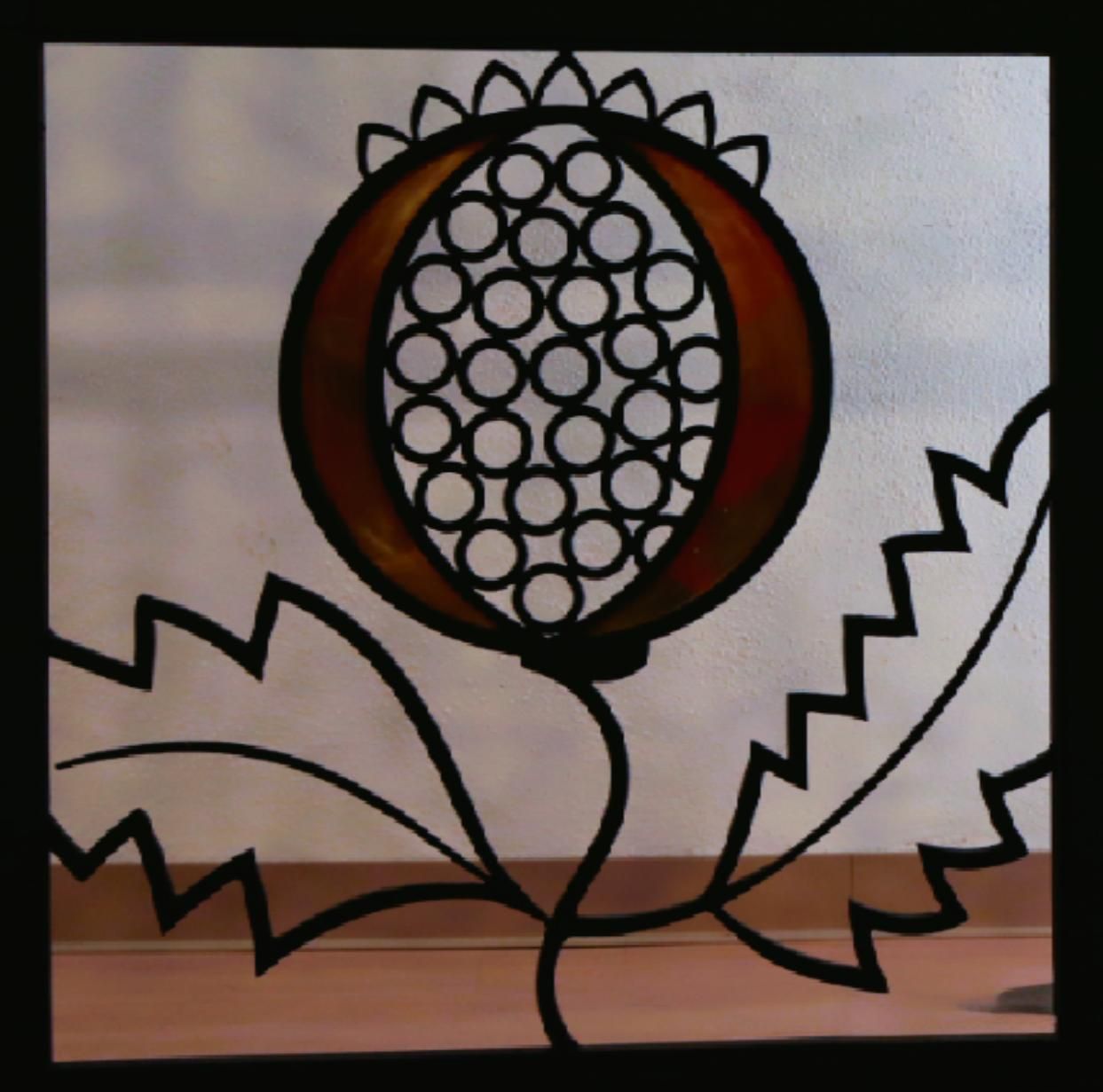
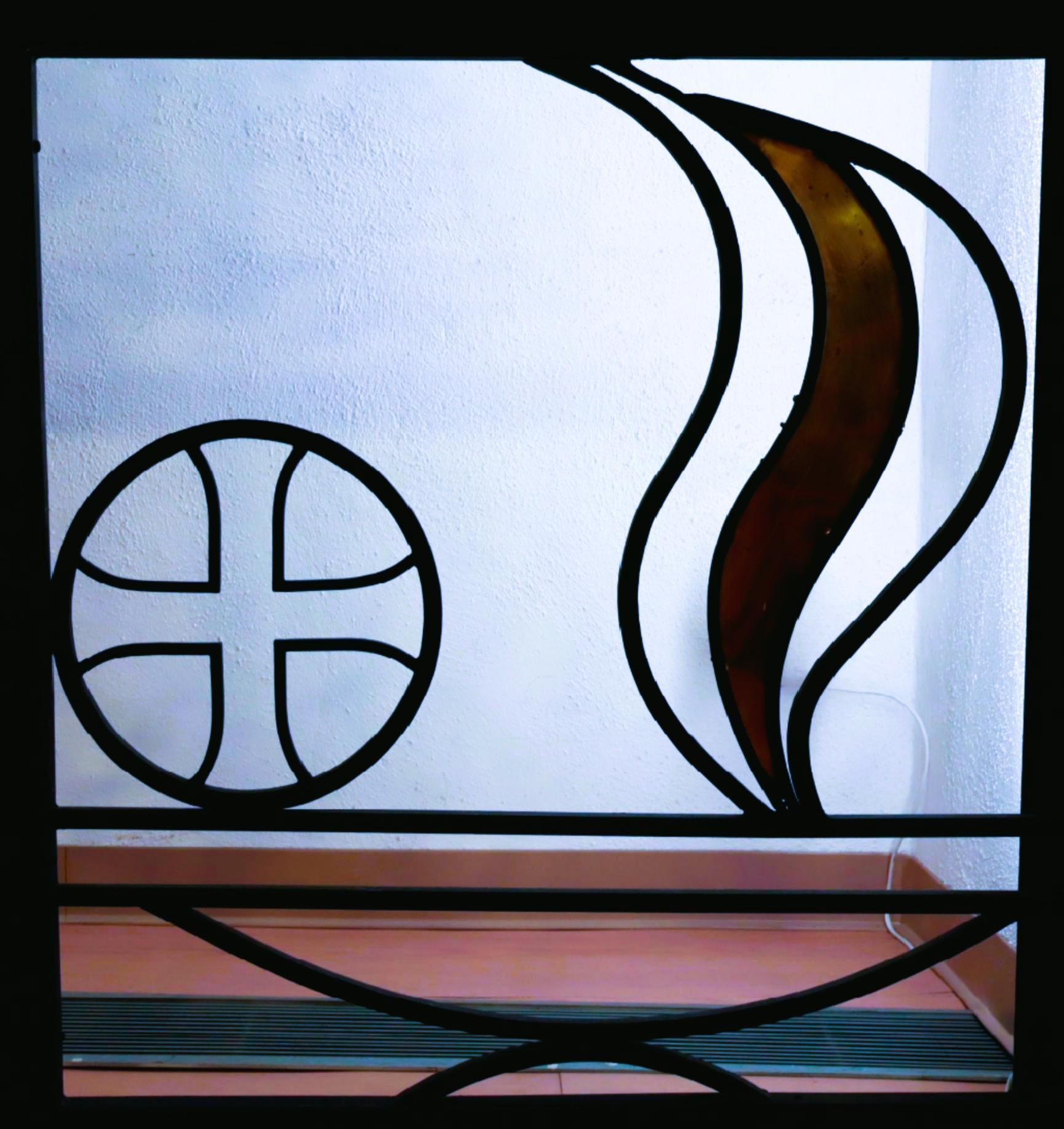
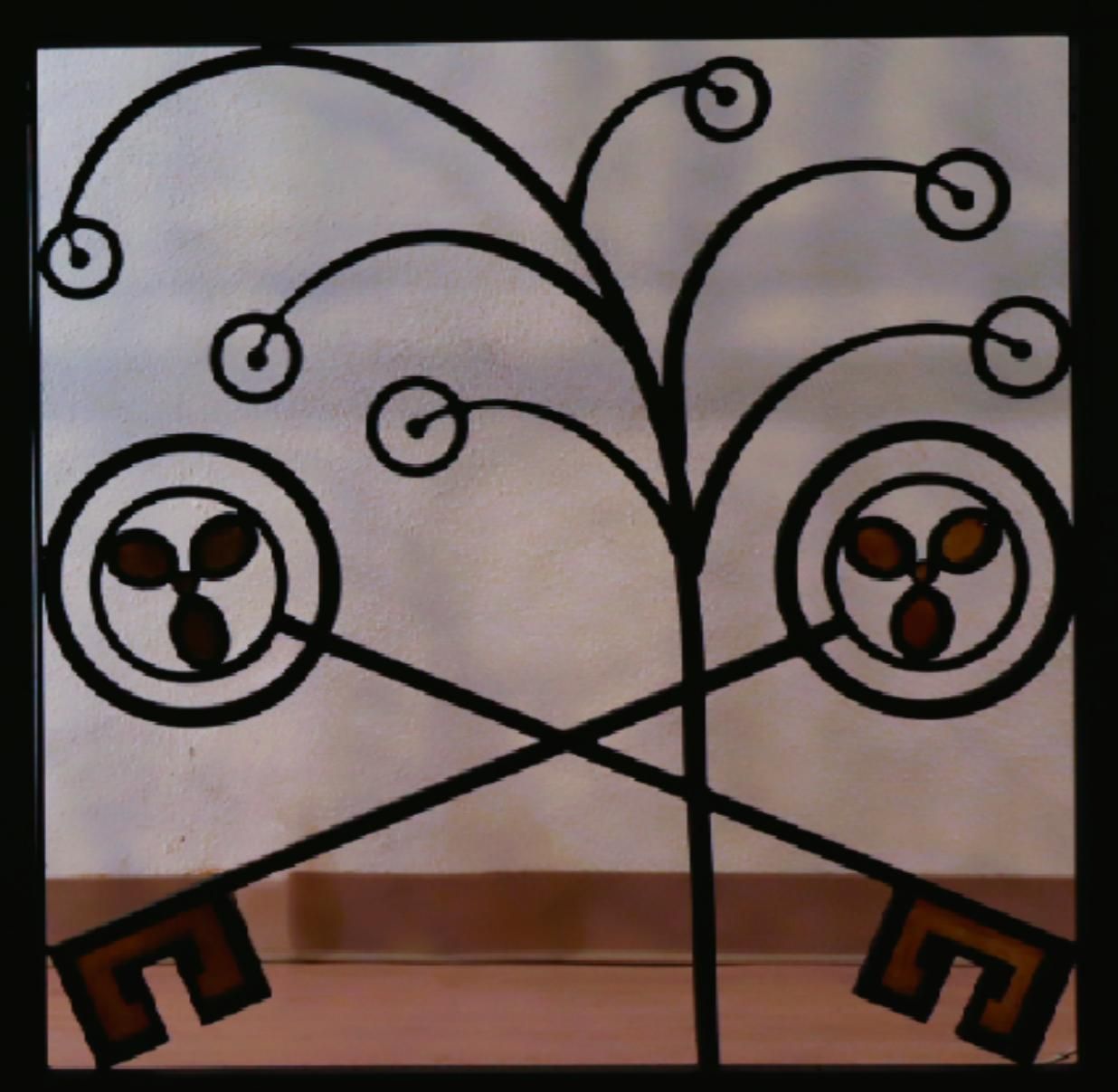
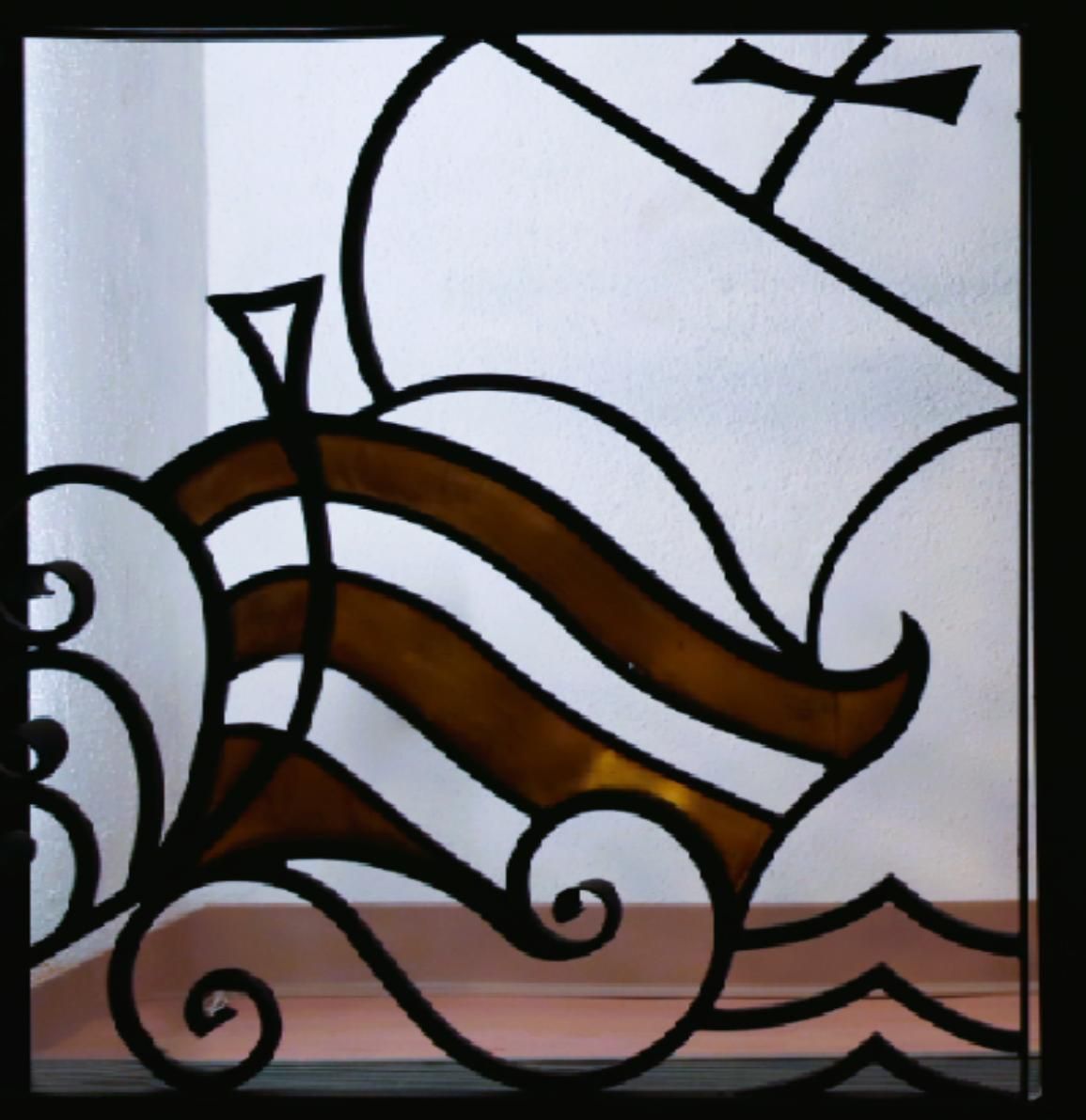
The bottom row of panels on the Altar Screen represents 4 marks of the Church, the same 4 we say when we recite the Nicene Creed: that the Church is one, holy, catholic, and apostolic.
The Church is ONE. There were pomegranate decorations on the vestments of Aaron, the first High Priest, and on Solomon’s Temple, an ancient symbol of the creative power of God, the immense variety of His creations, and His many blessings for us. The Church has also adopted this symbol to represent the unity of the many believers of Christ. Each seed is able to sprout into new life and all those seeds are held together as one fruit, just as the multitude of the faithful are held together as one Church. The Church is one because it is united under one Lord, Jesus Christ, and shares one faith, one baptism, and one Spirit. This unity transcends geographical and cultural boundaries. This “one-ness” is a reflection of the unity of the Trinity: the Father, the Son, and the Holy Spirit.
The Church is HOLY. The Catechism of the Catholic Church (#823) says: ““The Church . . . is held, as a matter of faith, to be unfailingly holy. This is because Christ, the Son of God, who with the Father and the Spirit is hailed as ‘alone holy,’ loved the Church as his Bride, giving himself up for her so as to sanctify her; he joined her to himself as his body and endowed her with the gift of the Holy Spirit for the glory of God. The Church, then, is ‘the holy People of God.’” This panel has a depiction of the Most Holy Trinity that the Church strives to share with the world. The brazier is God the Father, the host is God the Son, and the flame is God the Holy Spirit. Within the brazier, the fire of the Holy Spirit and Christ, the light of the world, are kindled. The Church teaches the holy doctrines given by God through Jesus in the Gospels and administers His sacraments by invoking the Holy Spirit to sanctify our lives and to lead people to holiness.
The Church is CATHOLIC. The definition of the word catholic is: “including a wide variety of things; all encompassing; universal.” When we pray the Nicene Creed, we pray for the catholic Church, using the lowercase “c” for the universal Church since the Church established by Jesus was for all of humankind. This panel of the Altar Screen uses a ship as a symbol for the Church’s efforts to carry the Gospel out so that everyone everywhere can come to know God and the salvation he has prepared for us. Just as Noah’s Ark preserved creation, the Church is the vessel that preserves the Joy of the Gospel. Just as Paul braved storms and endured shipwrecks to spread the teachings of Jesus, the Church is “Christ’s instrument. She is taken up by Him also as the instrument for the salvation of all, the universal sacrament of salvation by which Christ is at once manifesting and actualizing the mystery of God’s love for men. The Church is the visible plan of God’s love for humanity because God desires that the whole human race may become one People of God, form one Body of Christ, and be built up into the temple of the Holy Spirit.” (CCC 776).
The Church is APOSTOLIC. Jesus’ closest disciples were sent by Him as emissaries to carry the Good News out into the world after His resurrection. In the Gospel of Matthew, Jesus says he will give Peter the Keys to the Kingdom of Heaven, so the Church uses keys as a symbol of her Apostolic heritage of Faith, Purpose, and Office. The “deposit of faith” established by the teachings of Jesus has been entrusted to the Church and she strives to preserve and reflect the complete faith and doctrine given to, and through, the Apostles. Christ commissioned the Apostles to proclaim the Gospel and shepherd God’s people. The Church’s enduring purpose is to faithfully carry on that mission, just as the Apostles did. The Church has maintained an uninterrupted succession from the original Apostles through its ordinations. All priests and deacons have been ordained by bishops who were themselves ordained through a direct line that traces its roots to the Apostles. Also seen in this panel is an olive branch, which is a metaphor from St Paul’s Letter to the Romans: we are the branches that are grafted onto the stem “and have come to share in the rich root of the olive tree.” The Church cares for the “roots” and facilitates each of us being “grafted on” through teaching and the Sacraments.
The Seven Sacraments
[CCC 1113] The whole liturgical life of the Church revolves around the Eucharistic sacrifice and the sacraments. There are seven sacraments in the Church: Baptism, Confirmation or Chrismation, Eucharist, Penance, Anointing of the Sick, Holy Orders, and Matrimony. [CCC 1115] Jesus’ words and actions during his hidden life and public ministry were already salvific, for they anticipated the power of his Paschal mystery. They announced and prepared what he was going to give the Church when all was accomplished. The mysteries of Christ’s life are the foundations of what he would henceforth dispense in the sacraments, through the ministers of his Church, for “what was visible in our Savior has passed over into his mysteries.”
Jesus instructed his apostles to “make disciples of all nations, baptizing them in the name of the Father, and of the Son, and of the Holy Spirit.” Through baptism, we are purified- cleansed from original sin; justified- incorporated into the Body of Christ; sanctified- given the gifts of grace; and sealed- marked for eternal salvation. We may take for granted that water is used for baptisms, however, it is an exceptional choice due to the many ways water has been present in our salvation history: The waters of Genesis that life and lands are called forth from, the waters of the flood, the parting of the Red Sea, crossing over the Jordan River into the promised land, Christ’s own baptism in the Jordan, the water that poured from Christ’s side at his crucifixion… we find the life-giving nature of water in abundance.
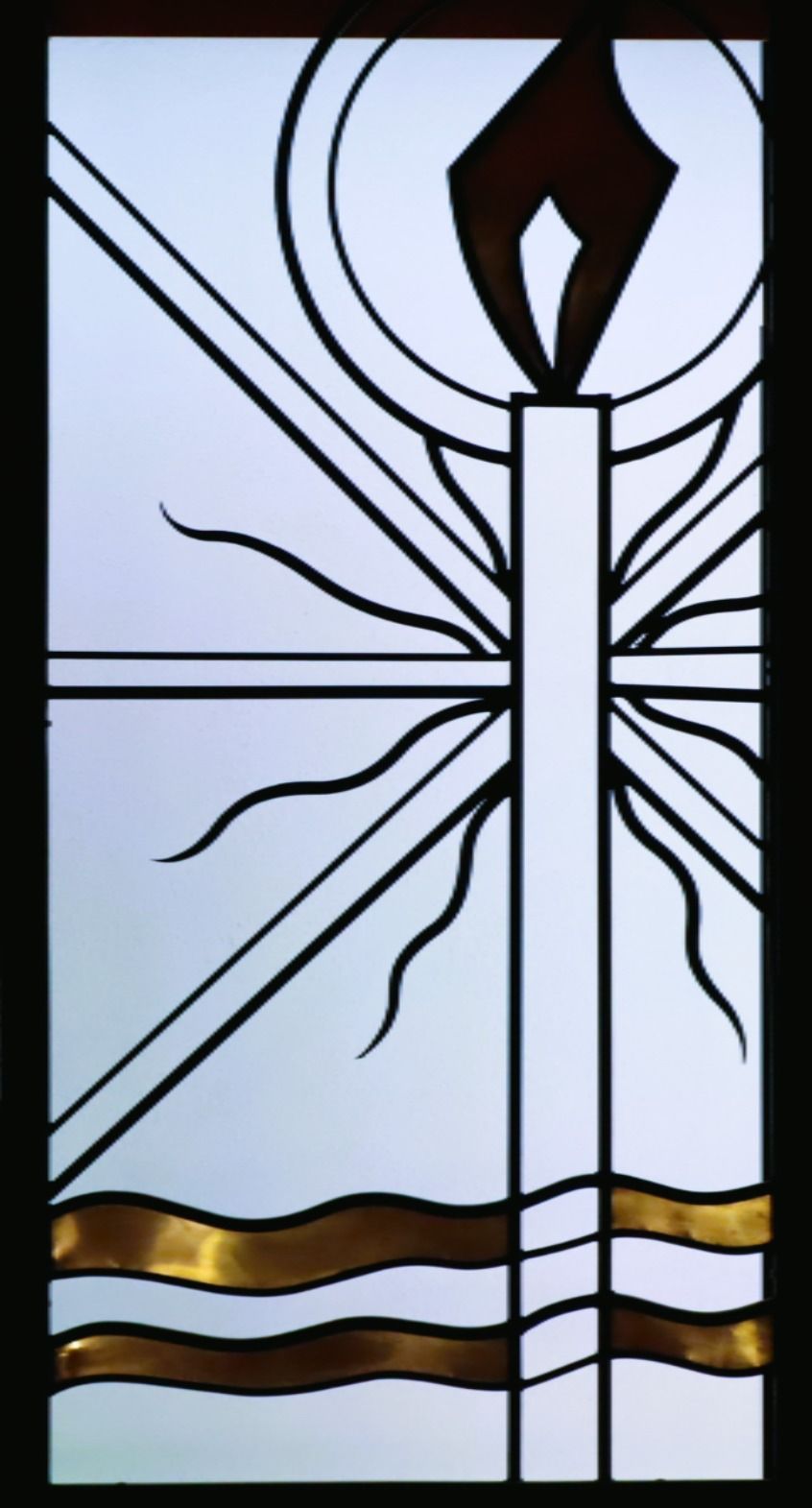
In this panel, you will also see the Easter Candle because we are not just baptized into the life of Christ, but also his death and resurrection. Parents and Godparents are given the light of Christ at their child’s baptism and instructed to keep it burning brightly so that their child may walk always as a child of the light. The path we must walk is also given to us in baptism, when we are anointed as Priest, Prophet, and King. This three-part mission means we must offer the best of ourselves up to God, always be ready to talk to and about God, and embody Christ’s example of servant leadership to use what authority and agency we have to create the Kingdom of God for all.
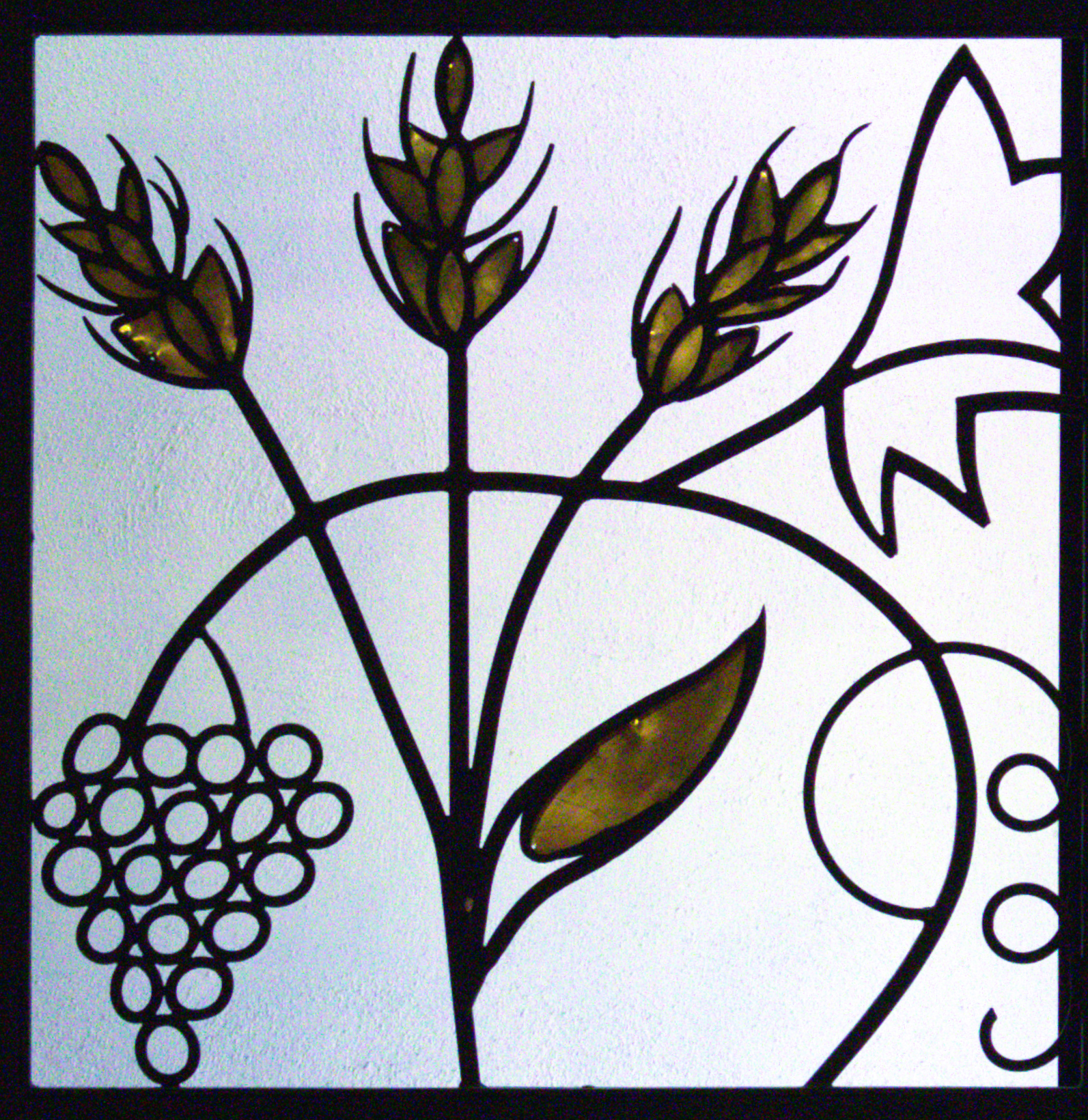
[Luke 22:19-20] “Then he took the bread, said the blessing, broke it, and gave it to them, saying, ‘This is my body, which will be given for you; do this in memory of me.’ And likewise the cup after they had eaten, saying, ‘This cup is the new covenant in my blood, which will be shed for you.’” In his commentary on this passage, St Cyril says: “Do not doubt whether this is true, but rather receive the words of the Savior in faith, for since he is the truth, he cannot lie.” He offers us his body, blood, soul, and divinity through the Sacrament of Eucharist and assures us of his Real Presence through the truth of his Word. This panel has the wheat and grapes, fruits of God’s blessings of a bountiful harvest, which become the bread and wine, fruits of our hands that we bring up at the Offertory of Mass.
God’s gifts of wheat and grapes are transformed by us into the gifts of bread and wine, and then transformed by Him into the Body and Blood of Christ, so that we, ourselves, can be transformed by the strengthening of our charity, the wiping away of our venial sins, and enabling us to break our disordered attachments and root ourselves in him through our reception of Holy Communion [CCC 1394]. The Paschal Mystery we celebrate at Mass is the core of the Christian Faith. It invites us to die with Christ to sin and rise to new life with him. Continual education about, reflection on, and reception of the Eucharist deepens our understanding of this Mystery, so it is important to keep those three actions as a regular part of our spiritual diet.
Through this Sacrament of many names, “the Lord Jesus Christ, physician of our souls and bodies, who forgave the sins of the paralytic and restored him to bodily health, has willed that his Church continue, in the power of the Holy Spirit, his work of healing and salvation, even among her own members” [CCC 1421]. It is known as the sacrament of: conversion, penance, confession, forgiveness, and reconciliation [see CCC 1423-1424], all of which speak to our understanding of Jesus’ call to “repent and believe in the Gospel” [Mark 1:15].
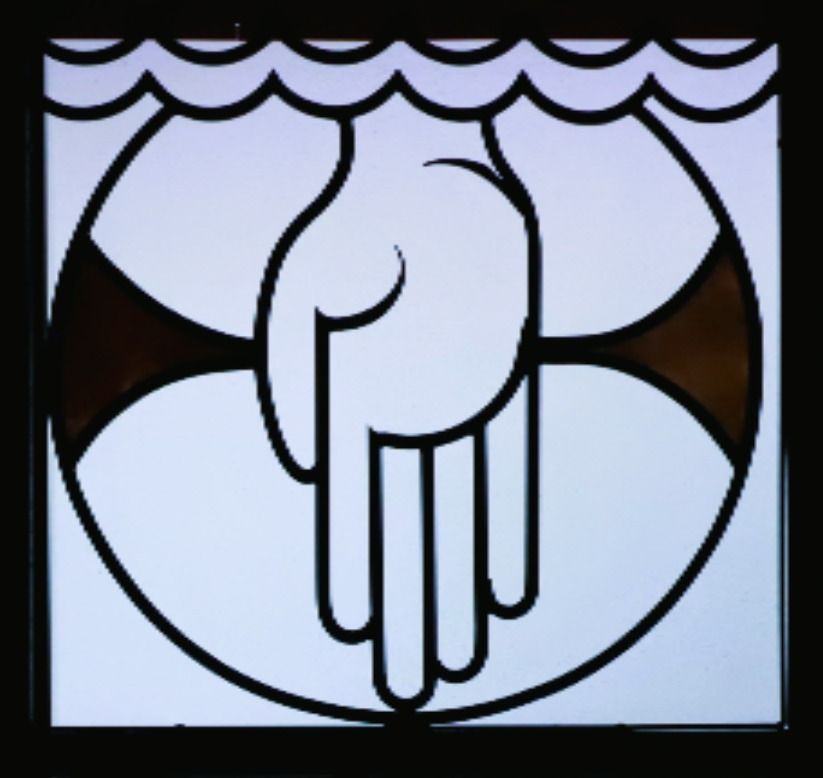
This panel has the outstretched hand of God, always ready to receive us when we decide to bring our broken, sinful selves to Him to receive His absolution through His unfailing mercy. God does not keep us at arm’s length until we are worthy of His presence, He keeps us in arm’s reach to hold us when we are ready to allow Him to.
This is why internal repentance is the core of this sacrament and not the outward trappings of a show of repentance. “Interior repentance is a radical reorientation of our whole life, a return, a conversion to God with all our heart, an end of sin, a turning away from evil, with repugnance toward the evil actions we have committed. At the same time it entails the desire and resolution to change one’s life, with hope in God’s mercy and trust in the help of his grace” [CCC 1431].
Jesus is known as “the Messiah” and “the Christ,” both of which mean “the anointed one.” The symbolism of anointing with oil is synonymous with the Holy Spirit. In the Hebrew scriptures, anointings occur as a sign that someone has been chosen by God to fulfill a particular purpose. The Holy Spirit is seen as the source of the power that it imparts, bestowing spiritual gifts and strength to fulfill the divine calling. Now, Jesus abundantly pours out the Holy Spirit and the Sacrament of Confirmation celebrates our reception of that Spirit. “Confirmation is necessary for the completion of baptismal grace, for ‘by the sacrament of Confirmation, [the baptized] are more perfectly bound to the Church and are enriched with a special strength of the Holy Spirit. Hence they are, as true witnesses of Christ, more strictly obliged to spread and defend the faith by word and deed’” [CCC 1293].
Through the laying on of hands from the Bishop and the anointing with Sacred Chrism, we welcome the Holy Spirit into our lives and Confirm our discipleship, our commitment to bringing the Spirit into the world and to do our part to build the Kingdom of God. When the Holy Spirit descended upon Jesus at his baptism, it is described as descending “like a dove,” which is why the panel that represents Confirmation in the Altar Screen has the image of a dove. Just as the dove signaled the start of a new world after the flood, its purity and peace signals our new start at the completion of our Initiation into the Church, the Body of Christ.
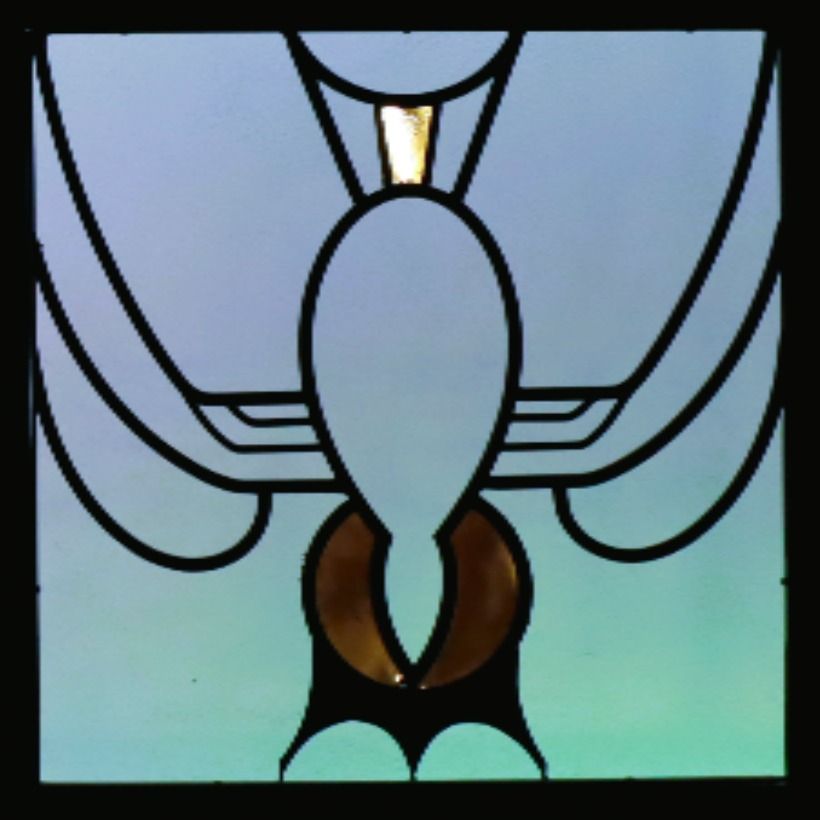
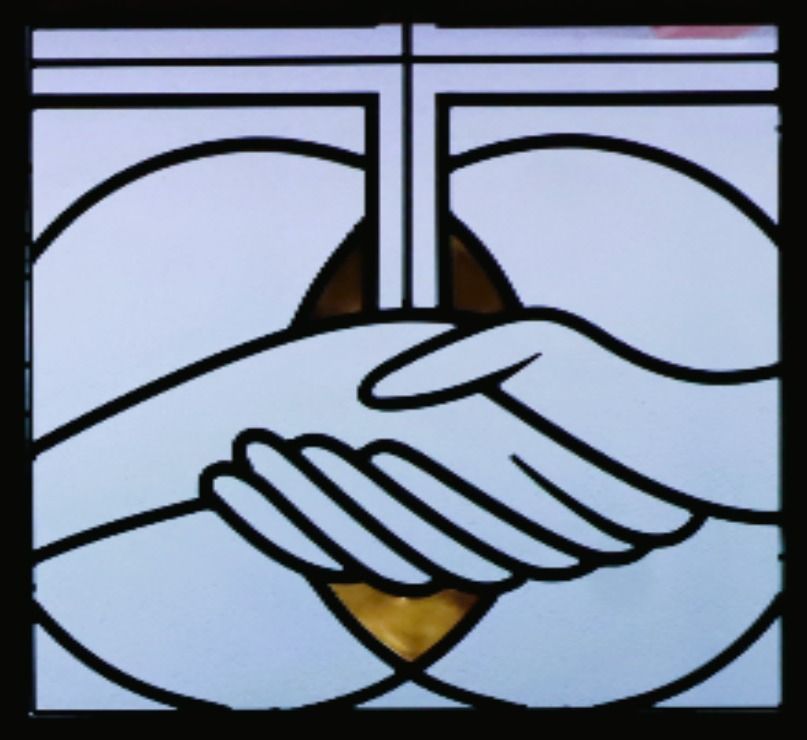
“So they are no longer two, but one flesh. Therefore, what God has joined together, no human being must separate” [Matthew 19:6]. The Sacrament of Matrimony imparts the grace of God to and through the commitment that two people make to one another. “By reason of their state in life and of their order, Christian spouses have their own special gifts in the People of God.
This grace proper to the sacrament of Matrimony is intended to perfect the couple’s love and to strengthen their indissoluble unity. By this grace they help one another to attain holiness in their married life and in welcoming and educating their children” [CCC 1641]. The family that is begun with the Sacrament of Matrimony and expanded with the birth of each child is known as the Domestic Church. When a family orients itself around its faith and works to help each other on their life’s journey toward God, they are cooperating with God’s plan for this institution.
God brings us together as family so that we can share God with one another and have the support we need to grow in holiness and pass the knowledge of and faith in God to the next generation. When Jesus says that there is no greater love than to lay down one’s life for one’s friends, he is providing a model for the domestic church to follow. He does not only mean that there is great love in sacrificing one’s life for the protection of another, he also means that there is great love in setting aside a life we could have spent for our sole benefit and instead embarking on a path that shares our time, effort, and energy for the benefit of others, especially our family.
This panel displays a stole, the Missal, and the Eucharist, which are emblematic of the ministry that flows from the Sacrament of Holy Orders, through which the mission Christ entrusted to his apostles continues to be exercised in the Church until the end of time [CCC 1536]. This sacrament is comprised of three distinct and hierarchical degrees: the Episcopate (bishops), the Presbyterate (priests), and the Diaconate (deacons).
Bishops, who receive the fullness of the Sacrament, are considered the authentic successors of the apostles and visible heads of a diocese, with the offices of teaching and governing [CCC 1557]. Priests are ordained as co-workers of the bishops, primarily called to preach the Gospel and celebrate divine worship, acting as agents of Christ in the sacraments, especially the Eucharist [CCC 1562]. The Diaconate is not ordained to the ministerial priesthood, but to service (diakonia) in the liturgy, the word, and charity, assisting the bishops and priests in their duties [CCC 1569].

A central and permanent effect of this sacrament is the imparting of an indelible spiritual mark, or character, which configures the recipient to Christ as Priest, Prophet, and King, and is received only once [CCC 1582]. Through the sacramental grace, the minister is empowered to act in the name and person of Christ the Head (in persona Christi Capitis), enabling the Church’s continuity and mission [CCC 1548]. Holy Orders is therefore essential to the Church's structure, ensuring the uninterrupted governance, sanctification, and teaching of the faithful by shepherds chosen for selfless service, having received their “holy orders” through direct succession from Jesus and the Apostles.
This panel of the Altar Screen is a depiction of an ambry, the resting place for the Holy Oils used in the Sacraments. The 3 olive branches in this panel represent the 3 Oils: The Oil of the Catechumens, used right before baptism, the Sacred Chrism, used right after baptism and at Confirmation and Priestly Holy Orders, and the Oil of the Sick, used for the Sacrament of Anointing of the Sick. All three are made from pure olive oil and are consecrated by the Bishop each year at a special Chrism Mass, celebrated shortly before Easter. Through the Sacrament of the Anointing of the Sick, we partake completely of the gifts of the Holy Spirit, having been introduced to those gifts in Baptism, made complete sharers of those gifts through Confirmation, and strengthened by those gifts, with peace and courage, to overcome the difficulties that go with serious illness, injury, or frailty.
From ancient times in the liturgical traditions of both East and West, we have testimonies to the practice of anointings of the sick with blessed oil. Over the centuries the Anointing of the Sick was conferred more and more exclusively on those at the point of death. Because of this it received the name “Extreme Unction” or “Last Rites” [CCC 1512]. However, The Anointing of the Sick “is not a sacrament for those only who are at the point of death. Hence, as soon as anyone of the faithful begins to be in danger of death from sickness or old age, the fitting time for them to receive this sacrament has certainly already arrived” [CCC 1514]. The Sacrament is celebrated by a priest, who anoints the head and hands of the infirm person, as well as praying over them in the faith of the Church.

Since Word and Sacrament form an indivisible whole, the celebration of this Sacrament is opened with a Liturgy of the Word, and is ideally situated between the Sacraments of Penance and Eucharist [CCC 1517-18].This assistance from the Lord by the power of his Spirit is meant to lead the sick person to healing of the soul, but also of the body, if such is God’s will [CCC 1520].

The Lamb of Victory “They will fight with the Lamb, but the Lamb will conquer them, for he is Lord of lords and king of kings, and those with him are called, chosen, and faithful” [Revelation 17:14]. The Book of Revelation has 29 references to a lion-like lamb, who represents Christ and his victory over death. Saint John also uses the image of a lamb in his Gospel, calling Jesus “the Lamb of God.” This image is a particularly powerful theme of our faith. In the Hebrew Scriptures, lambs are sacrificed for the atonement of sins. Jesus became that sacrificial lamb, taking on the sins of humanity and offering his own life in atonement for us. After his death, Christ’s resurrection reveals to us the sincerity of his promise of eternal life with him and the Father in heaven. By his sacrifice, we are redeemed. Through his victory over death, we have a path to everlasting life. This Lamb of Victory, who is the Lord of all humanity and king of all kings, brings to fulfillment God’s promise for our salvation. The flag this lamb holds is a banner for us to gather around. It calls out to the chosen, and the faithful respond. This panel stands above the cross, a symbol of Christ’s triumph over the cross. At Mass, we celebrate this victory through the Eucharist. One of the last things we hear before we receive the Body and Blood of Christ is the call to “behold the lamb of God. Behold him who takes away the sins of the world.” When we look, we see the unblemished lamb that is sacrificed for our sake. We are, of course, unworthy of this gift, but he need “only say the word and [our souls] shall be healed.” His victory becomes our strength through communion with the Lamb of God.
